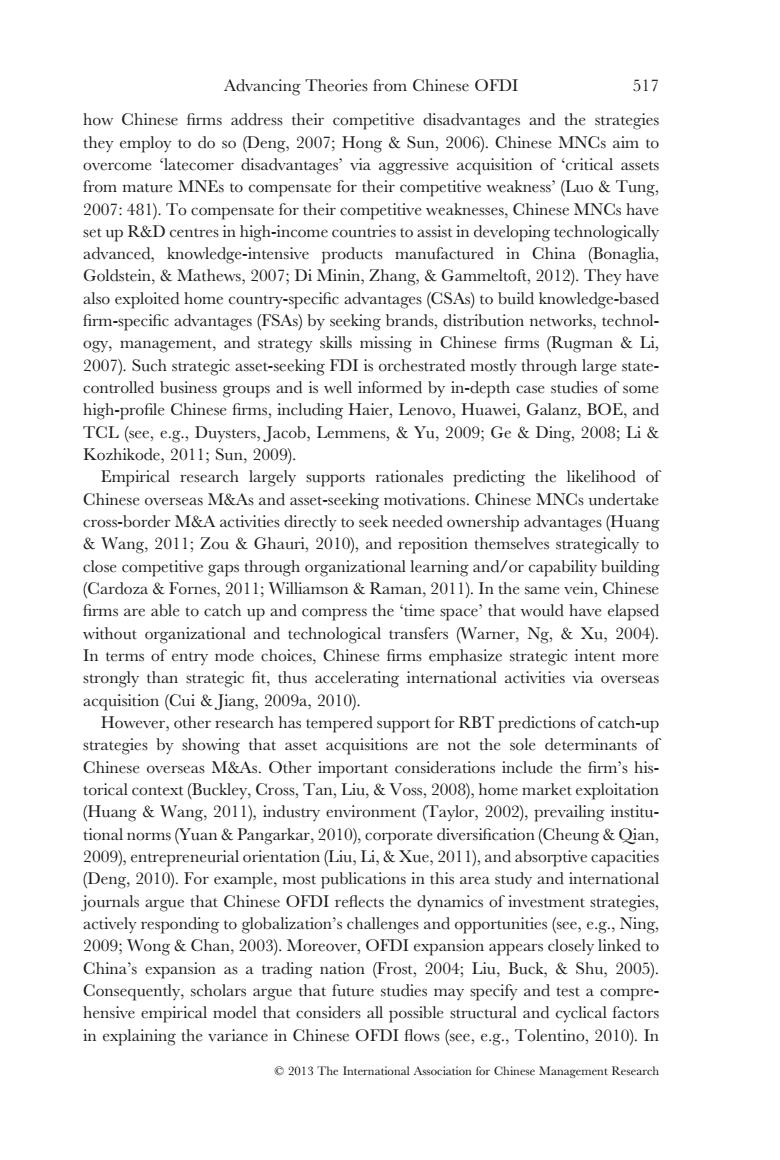正在加载图片...

Advancing Theories from Chinese OFDI 517 how Chinese firms address their competitive disadvantages and the strategies they employ to do so (Deng,2007;Hong Sun,2006).Chinese MNCs aim to overcome latecomer disadvantages'via aggressive acquisition of 'critical assets from mature MNEs to compensate for their competitive weakness'(Luo Tung. 2007:481).To compensate for their competitive weaknesses,Chinese MNCs have set upR&D centres in high-income countries to assist in developing technologically advanced knowledge-intensive products manufactured in China (Bonaglia, Goldstein,Mathews,2007;Di Minin,Zhang,Gammeltoft,2012).They have also exploited home country-specific advantages(CSAs)to build knowledge-based firm-specific advantages(FSAs)by seeking br nds,distribution networks,technol- ogy,management,and strategy skills missing in Chinese firms (Rugman&Li, 2007).Such strategic asset-seeking FDI is orchestrated mostly through large state- controlled business groups and is well informed by in-depth case studies of some high -profile Chinese firms,including Haier,Lenovo H ei,Galanz,BOE,and TCL (see,e.g.,Duysters,Jacob,Lemmens,Yu,2009;Ge Ding,2008;Li Kozhikode,2011;Sun,2009). Empirical research largely supports rationales predicting the likelihood of Chinese overseas M&As and asset-seeking motivations.Chinese MNCs undertake cross-border M&A activities directly to seek needed ownership advantages(Huang Wang,2011;Zou Ghauri,2010),and reposition themselves strategically to close compe ps through organizational learning and/or capability building CardoaFome.2011:Wlamson&Raman.2011).In the same vein.Chines firms are able to catch up and compress the 'time space'that would have elapsed without organizational and technological transfers (Warner,Ng,Xu,2004). In terms of entry mode choices,Chinese firms emphasize stra intent more strongly than strategic fit,thus accelerating international activities via overseas acquisition (Cui Jiang,2009a,2010). However,other research has tempered support for RBT predictions of catch-up strategies by showing that asset acquisitions are not the sole determinants of Chinese overseas M&As.Other important considerations include the firm's his- torical context(Buckley,Cross,Tan,Liu,Voss,2008),home market exploitation (Huang Wang,2011),industry environment(Taylor,2002),prevailing institu- tional norms(Yuan Pangarkar,2010),corporate diversification (Cheung &Qian, 2009),entrepreneurial orientation (Liu,L.Xue,2011),and absorptive capacities (Deng,2010).For example,most publications in this area study and international journals argue that Chinese OFDI reflects the dynamics of investment strategies actively respond ing to globalization's challenges and opportunities(see,e.g.,Ning 2009;Wong Chan,2003).Moreover,OFDI expansion appears closely linked to China's expansion as a trading nation (Frost,2004;Liu,Buck,Shu,2005). Consequently,scholars argue that future studies may specify and test a compre hensive empirical model that considers all possible structural and cyclical factors in explaining the variance in Chinese OFDI flows(see,e.g.,Tolentino,2010).In 2013 The International Association for Chinese Management Research how Chinese firms address their competitive disadvantages and the strategies they employ to do so (Deng, 2007; Hong & Sun, 2006). Chinese MNCs aim to overcome ‘latecomer disadvantages’ via aggressive acquisition of ‘critical assets from mature MNEs to compensate for their competitive weakness’ (Luo & Tung, 2007: 481). To compensate for their competitive weaknesses, Chinese MNCs have set up R&D centres in high-income countries to assist in developing technologically advanced, knowledge-intensive products manufactured in China (Bonaglia, Goldstein, & Mathews, 2007; Di Minin, Zhang, & Gammeltoft, 2012). They have also exploited home country-specific advantages (CSAs) to build knowledge-based firm-specific advantages (FSAs) by seeking brands, distribution networks, technology, management, and strategy skills missing in Chinese firms (Rugman & Li, 2007). Such strategic asset-seeking FDI is orchestrated mostly through large statecontrolled business groups and is well informed by in-depth case studies of some high-profile Chinese firms, including Haier, Lenovo, Huawei, Galanz, BOE, and TCL (see, e.g., Duysters, Jacob, Lemmens, & Yu, 2009; Ge & Ding, 2008; Li & Kozhikode, 2011; Sun, 2009). Empirical research largely supports rationales predicting the likelihood of Chinese overseas M&As and asset-seeking motivations. Chinese MNCs undertake cross-border M&A activities directly to seek needed ownership advantages (Huang & Wang, 2011; Zou & Ghauri, 2010), and reposition themselves strategically to close competitive gaps through organizational learning and/or capability building (Cardoza & Fornes, 2011; Williamson & Raman, 2011). In the same vein, Chinese firms are able to catch up and compress the ‘time space’ that would have elapsed without organizational and technological transfers (Warner, Ng, & Xu, 2004). In terms of entry mode choices, Chinese firms emphasize strategic intent more strongly than strategic fit, thus accelerating international activities via overseas acquisition (Cui & Jiang, 2009a, 2010). However, other research has tempered support for RBT predictions of catch-up strategies by showing that asset acquisitions are not the sole determinants of Chinese overseas M&As. Other important considerations include the firm’s historical context (Buckley, Cross, Tan, Liu, & Voss, 2008), home market exploitation (Huang & Wang, 2011), industry environment (Taylor, 2002), prevailing institutional norms (Yuan & Pangarkar, 2010), corporate diversification (Cheung & Qian, 2009), entrepreneurial orientation (Liu, Li, & Xue, 2011), and absorptive capacities (Deng, 2010). For example, most publications in this area study and international journals argue that Chinese OFDI reflects the dynamics of investment strategies, actively responding to globalization’s challenges and opportunities (see, e.g., Ning, 2009; Wong & Chan, 2003). Moreover, OFDI expansion appears closely linked to China’s expansion as a trading nation (Frost, 2004; Liu, Buck, & Shu, 2005). Consequently, scholars argue that future studies may specify and test a comprehensive empirical model that considers all possible structural and cyclical factors in explaining the variance in Chinese OFDI flows (see, e.g., Tolentino, 2010). In Advancing Theories from Chinese OFDI 517 © 2013 The International Association for Chinese Management Research